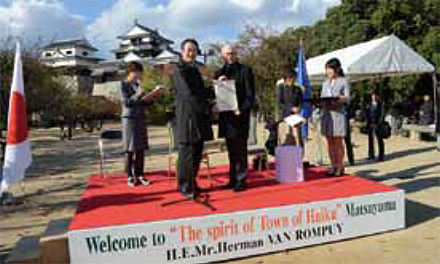Diplomatic Bluebook 2014 Summary
Chapter 4
Japan’s Diplomacy Open to the Public
I am sure that many Japanese people have composed haiku poetry during their elementary school Japanese classes, but did you know that the haiku poetry form has spread from Japan to some 70 countries, where people enjoy haiku in their own language? Since 2009, Japan and the European Union (EU) have held a Japan–EU English Haiku Contest annually, and to date more than 2,000 people have participated in this contest.
| The three disasters (仮訳:嵐去り |
Storms turn into a soft wind 後に残るは |
A new humane wind 優しき心) |
The haiku above was composed by President of the European Council Herman Van Rompuy—one of the leaders of the EU. He presented his haiku at the annual Japan–EU Summit Meeting held in May 2011, shortly after the Great East Japan Earthquake. President Van Rompuy is well-known not only as a politician but also as a devotee of haiku. On November 18, 2013, he visited Matsuyama City, Ehime Prefecture, the birthplace of Masaoka Shiki— one of the great haiku masters. During his visit, President Van Rompuy was warmly welcomed by Matsuyama Mayor Katsuhito Noshi and citizens of Matsuyama. President Van Rompuy talked about his passion for haiku, saying, “I wish to contribute to the joy and happiness of people by composing haiku as a ‘haiku ambassador.’”
The next day, at the annual Japan–EU Summit Meeting in Tokyo, President Van Rompuy presented the following piece.
 President of the European Council Van Rompuy receives the title of Honorary Citizen of Matsuyama by Mayor Noshi. Matsuyama Castle can be seen in the upper background.
President of the European Council Van Rompuy receives the title of Honorary Citizen of Matsuyama by Mayor Noshi. Matsuyama Castle can be seen in the upper background.
People far away
But sun and stars on our flags
Belong together
In response, Japanese Prime Minister Shinzo Abe composed an impromptu haiku.
Star-filled sky
Looking up at the stars at night
Dear friends join
This was the first occasion on which both leaders of Japan and the EU have presented haiku together. This exchange of haiku on the theme of Japan–EU relations helped to create a genial atmosphere at the meeting, and brought the leaders much closer together.
The power of haiku is not limited to the promotion of people-to-people exchanges between Japan and other countries through Japanese culture. Composing haiku can also be an opportunity for greater self-reflection. Focusing on this point, the European Commission decided to implement haiku poetry courses in prisons in 2013–2014 as part of their correctional education program. The haiku course has been or will be provided at 14 prisons in five EU member states—Belgium, Poland, Italy, Greece and Serbia. At the prison in Belgium, where the haiku course has already been provided, it was reported that all 10 participants faced themselves more squarely as a result of the course. The full potential of haiku is yet to be uncovered.
Sincerely hoping that haiku, as a bridge between Japan and the world, will help to bring joy and happiness to someone somewhere in the world, I would like to close with my own haiku.
| Walk on the rainbow (この虹を |
Hoping to see smiles and dreams 辿れば友の |
A new humane wind |
Official, European Policy Division
European Affairs Bureau
Haiku kigo, a seasonal word/reference, to describe the season and consists of three phrases. But, there are no strict rules on English haiku composition, and a kigo is not essential, although a three-line haiku is desirable.

